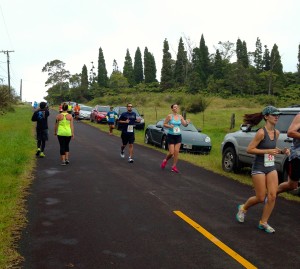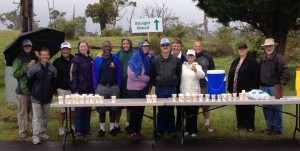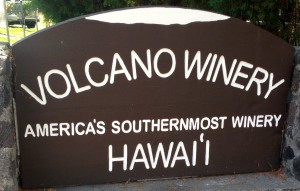Rotary Club of Hilo Bay staffs Aid Station Number 5 at the annual Volcano Rain Forest Run. Station 5 at the corner of Wright and Amaumau Roads had a slightly funky appearance this year due to the first purple portable toilet I’ve seen. I’m more accustomed to motley green or brown colors. But purple has a certain charm providing an accent to the lush green of the Volcano Rain Forest.
The annual run is really three events: a Half Marathon, 10 K Run, and 5 K run. Half Marathon runners start at 7:00 a.m. with the 5 K folks trotting off at 8:00. This year runners started in heavy mists that soon became heavy drizzling rain. Elevation: 4,000 feet. Half Marathoners had an elevation change of 500 feet as they made their way around the course. The others faced only slight elevation changes.

The first person to run – and I mean run – past our station was Billy Barnett in the 30-39 age division who completed the half Marathon in 1:18:41. Katherine O’Neil in the 20-29 division was the first wahine with a time of 1:25:09. But not everyone is built for speed. Participants included all ages and times, with the last finisher coming in 3:57:03.

At the aid station we offered three types of refreshment. Every time a runner approached one or more of us sang out: Water – Electrolytes – Gu (goo). We held out half filled cups that runners could grab on the fly, drink, and toss aside, theoretically without losing stride. But some folks stopped for a brief break before pushing ahead. Some asked where the rubbish bin was. All invariably thanked us. Runners are nice people. As time passed, several folks approached in a slow jog, which was even slower after they passed the turnaround. Everyone seemed to have, if not a good time, at least not an unpleasant one.

After the last participant passed the station about 10:00, we poured out the remaining cups, broke down the tables, and generally “policed” the area. It was time for a field trip to Volcano Winery, owned by Member Marie Bothof and her husband Del.
A Winery on lava at 4,000 feet?! Napa it isn’t. On the contrary, Volcano Winery is a boutique winery producing a unique selection of well-received wines, estate tea, and white figs. (Figs?)
Lynn “Doc” McKinney, a retired veterinarian from O`ahu, started the winery in 1986. He thought the climate at 4,000 feet would be perfect for growing Symphony grapes and planted 14 acres of grape vines. The winery opened its doors to the public in 1993. I heard that Doc McKinney charged $13.00 per bottle of wine. Times and marketing have changed since then.


Del and Marie Bothof purchased the winery in 1999 and have been hard at work at their labor of love ever since. They produce eight delightful varieties of wine – enthusiastically tasted by several Rotarians. The Hawaiian Guava-Grape Wine won a Silver Medal at the Pacific Rim International Wine Competition. I didn’t know guavas and white grapes could get along so well, but they do. Volcano Red, a medium bodied red wine, brought home a Bronze Medal from the 2013 Finger Lakes International Wine Competition.

Not fond of wine? Try one of the Three Varieties of Estate Grown Tea. Silver Needle Tea, White Tea, and Black Tea. Silver Needle is the straight leaf at the tippy, tippy top of the plant. White Tea includes the first leaf next to the needle, and Black Tea includes an additional leaf just below. As Del Bothof demonstrated the best tea leaves, I spotted a tea flower, a small white blossom nestled among the leaves. Volcano Winery introduced a product called Infusion made with Hawaiian macadamia nut honey from Kona and the Estate Black Tea. It came home from the Finger Lakes Competition with its own Bronze Medal.

The Bothofs are adding a new product to their repertoire: white figs. I can’t wait until next year to find out what they do with them.

Acknowledgements:
Photo of Rotarians at Aid Station 5 by Anita Cunningham. All Rights Reserved.
Other Photos by Author. All Rights Reserved.

Sandra Wagner-Wright holds the doctoral degree in history and taught women’s and global history at the University of Hawai`i. Sandra travels for her research, most recently to Salem, Massachusetts, the setting of her new Salem Stories series. She also enjoys traveling for new experiences. Recent trips include Antarctica and a river cruise on the Rhine from Amsterdam to Basel.
Sandra particularly likes writing about strong women who make a difference. She lives in Hilo, Hawai`i with her family and writes a blog relating to history, travel, and the idiosyncrasies of life.




Sandra is being characteristically modest. This is the single most important aid station on a very challenging course. The design of the course means that the same runner passes the aid station three times. So for every one runner the volunteers have the potential to have to make three (or more) hand-offs/assistance/helps.
Not only that, the aid station is placed strategically so that it has to handle water, electrolyte fluids (‘Gatorade’ being the generic…well…they don’t like to read that), and energy supplements like ‘Gu”. For some of us runners it is the first aid station we actually use. That depends on the weather–if it is cool and damp, as it was this past Saturday–then we typically stretch out the stops until this aid station. On the hot, sunny days, we’re drinking right from the first aid station onward.
Now, not to slight some of the other aid stations, some of them have to handle runners from two or all three of the different races, the 5K, 10K, and 1/2 marathon, so they see many participants, too.
All of the volunteers get there early and leave late.
Their efforts are very much appreciated by all the runners, from the first ones to the last. The runners know that without volunteers there is no event. Many runners also volunteer at different events through the year, and entry in to some runs is conditional upon showing that one has volunteered during that year at similar events.
Sandra and the other volunteer also provide the most amazing vocal support. This course hasn’t many spectators and the volunteers at all the aid stations are amazing in their enthusiasm and cheerfulness.
With appreciation and the hope of seeing all the Rotarians at Aid Station #5 next year,
David Hammes
Mahalo, David, for taking the time to amplify the work of aid station volunteers. Rotarians have been at Aid Station 5 for a number of years, and we look forward to it as a highlight of our community service. I should mention that Mary Bergier is the one who remembers to send around the sign up sheet and “reminder” map.